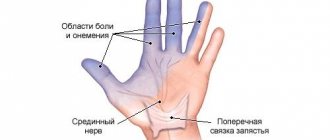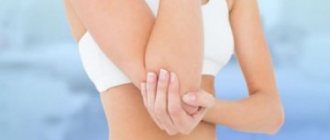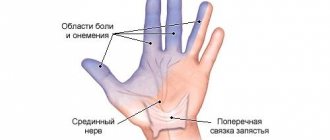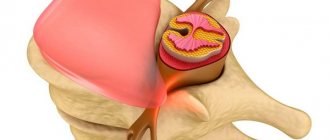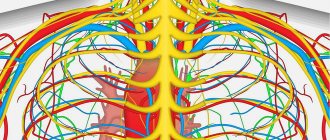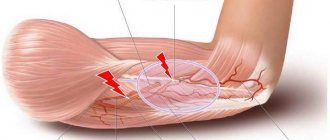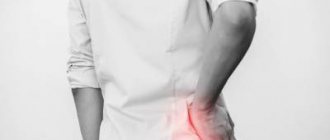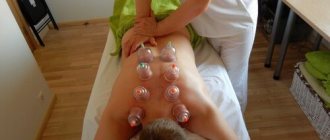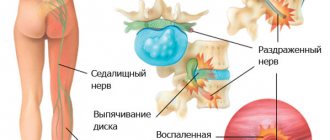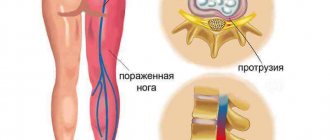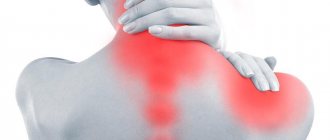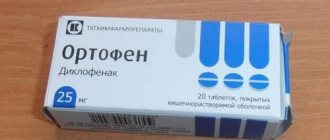If the ulnar nerve is affected, the mobility of the hand and its sensitivity decrease or completely disappear. This pathology in medicine is called neuropathy.
Neuropathy, according to the reasons that caused it, is divided into two categories:
- Post-traumatic;
- Compression.
Post-traumatic neuropathy is caused by stretching, partial tearing, or complete rupture of the elbow nerve. Such damage may be preceded by a subluxation of the elbow joint, a lateral dislocation, or an anterior dislocation accompanied by a fracture of the olecranon.
Compressive neuropathy is pinching of the ulnar nerve in narrow canals (in the cubital canal in the elbow joint or in Guyon's canal in the hand joint).
This happens when there is a tumor, inflammation or a change in the tissue structure in the canals. The causes are the following diseases:
- Rheumatoid arthritis.
- Deforming arthrosis.
- Chondromalacia and chondromatosis.
- Tenosenovitis and synovial cysts.
- Malignant formations.
- Pressure on the nerve of the abductor digiti minimi muscle.
Often, pinching of the ulnar nerve occurs during the process of realigning the joint during dislocation or combining bone fragments during a fracture. If skeletal traction is performed, passive stretching of the nerve at the elbow joint may also occur. This pathology is called secondary neuritis.
If the elbow joint is repeatedly damaged in the area where the nerve passes, late neuritis develops.
Ulnar nerve neuropathy - symptoms
Symptoms vary depending on the severity of the injury. With a complete rupture of the nerve in the elbow joint, the following are noted:
- Loss of sensitivity of the skin of the little finger and half of the ring finger;
- Paralysis of the flexor and adductor muscles of the thumb;
- Paralysis of the interosseous muscles in the area where the palm meets the fingers is called “claw finger syndrome.”
In case of incomplete nerve damage, the symptoms are as follows:
- Tingling sensation on the inside of the palm.
- Weakening of the muscles of the hand.
- Decreased muscle volume between the thumb and index finger.
- Loss of sensation in the little finger, partial numbness of the ring finger.
- Pain along the nerve of the elbow joint.
The more severe the damage to the nerve fibers, the more pronounced the symptoms will be.
Types of mononeuropathies
Mononeuropathies of peripheral nerves are most often caused by injury or compression (compression) in narrow anatomical formations - osteofibrous canals . The latter are peculiar tunnels that contain muscle tendons or blood vessels and nerves, so compression of the nerve in the mentioned channels can also be called “tunnel mononeuropathy.”
Read also: Subchondral sclerosis
Methods for diagnosing a pinched nerve in the elbow joint
To accurately make a diagnosis when examining a victim, Froman tests are performed. First, the patient should place his thumbs on the surface of the table so that the table cover is between them and the index fingers, and perform such a movement as if he is going to squeeze the cover.
Even with minor nerve damage, the patient will not be able to keep the thumb straight on the tabletop; he will lower it to his side and bend it.
Next, the patient is asked to grab a sheet of thick paper with the side surfaces of his fingers, but the fingers cannot be bent. The finger of the hand that is damaged will not be able to remain straight; it will bend at the interphalangeal joint.
The diagnosis is confirmed by Tinnel's symptom - the symptoms intensify if the doctor performs pressing movements along the cubital canal of the elbow joint. The degree of sensitivity is determined using light touches or injections on various parts of the hand.
To identify bone damage and other defects that may be causing a pinched nerve in the elbow, radiography, MRI, and ultrasound are performed. Ultrasound can also determine how severely the nerve is damaged.
A method such as electromyography allows you to determine whether there are disturbances in the conduction of impulses in the area located below the damaged nerve.
Treatment of a pinched ulnar nerve
Treatment of elbow neuropathy can be either surgical or conservative. The method is determined taking into account the cause of the pathology and the degree of nerve damage.
If there is no atrophy of muscle tissue and there is no persistent deformation of the fingers, conservative treatment is possible. When the nerve in the cubital canal is damaged, the following techniques are used:
- Compliance with a certain regime: loads should be minimal, monotonous movements should be avoided, and the arm should not be allowed to remain in a bent position for a long time.
- Treatment with non-steroidal anti-inflammatory drugs, which effectively relieve pain and inflammation, and B vitamins to improve blood circulation and metabolic processes in the damaged nerve.
When a nerve is pinched in Guyon's canal, the treatment is not fundamentally different, but the administration of glucocorticosteroids is added to the listed methods.
Surgical treatment is indicated if treatment with medications has not yielded results, if there are significant scars in the canals in the area of the nerve passage, or if it is necessary to restore the functionality of the hand as quickly as possible - for example, in professional athletes who cannot interrupt training to carry out conservative treatment.
Surgical treatment involves cutting the tissue and removing those parts that are compressing the nerve and causing inflammation. In some cases, to avoid re-damage to the nerve, it is transplanted to the inner surface of the elbow joint.
After surgery, a fixation splint is applied to the arm, after which restorative treatment is carried out using NSAID ointment, analgesics, vitamins, heat treatments and massage. Physical therapy is required after the splint is removed.
The ulnar nerve is indispensable in providing fine motor skills of the hand. Its fibers are responsible for sensitivity and finger movements. A pinched nerve in the elbow joint is dangerous due to partial disability, decreased quality of life due to pain, and the need for surgical intervention as the process progresses. The reasons for the infringement may be different, but in any case, in order to avoid sad complications, you need to consult a doctor in a timely manner and begin treatment.
Reasons for infringement
The most common reasons why the ulnar nerve can be pinched is hitting the elbow on a hard surface, working with constant emphasis on the elbow (on any machine, at a desk). Pinching is often caused by tumors that put pressure on the nerve. In addition, there are several other reasons that influenced the appearance of the disease:
- hypothermia, frequent stress;
- fracture or injury of the humerus, as well as the elbow joint;
- arthritis, arthrosis and other inflammatory processes in the elbow joint;
- regular work with vibrating tools (screwdrivers, drills, hammer drills);
- pinching often occurs among drivers who like to lean their elbow on the edge of an open window;
- The disease is often observed in athletes or those who like to ride a motorcycle;
- in disabled people, pinching can occur due to constant resting of the elbow on the armrests of the wheelchair;
- frequent flexion and extension of the arm.
Note. The injury may be primary (due to tumors, fractures, bruises) or secondary (as a consequence of inflammatory processes).
How does pathology occur?
The ulnar nerve originates from the brachial plexus and runs along the inner surface of the arm from the cervical spine to the fingers.
Anatomical features
The most dangerous areas in terms of pinching of nerve fibers are the elbow joint and Guyon's canal of the wrist joint. There, the nerve trunk runs along complex tendon-bone canals. Even minor deformations of cartilage, tendons or bone due to inflammation or injury lead to its pinching and carpal tunnel syndrome develops.
Clamping is also possible along the nerve fibers by an inflamed muscle or ligament, or a new formation of soft tissue. In the elbow joint, in some areas they lie very superficially, accessible to external pressure. Therefore, when you hit your elbow, you experience shooting pain and numbness that reaches your fingers.
This nerve contains sensory and motor fibers, which explains the occurrence of numbness, pain and limitation of movement when it is damaged. Violation of its motor function and nutrition lead to muscle atrophy and gradual deformation of the hand.
Causes of defeat
Pinching can be of different origins:
- compression of the nerve when frequently resting the arm on the elbow (office workers, wheelchair users and people who have the habit of constantly resting their elbow on the armrest of a chair or the edge of a table are vulnerable);
- injuries to the lower parts of the humerus, elbow joint, hand, including wounds, unsuccessful injections, dislocations, fractures, sprains;
- hernia of the cervical spine, compressing the branches of the brachial plexus;
- tumors of the ulnar nerve and soft tissues of the periarticular region;
- joint diseases (arthritis, arthrosis of the elbow or wrist joints);
- inflammation of the muscles of the forearm and hand, which innervate this nerve.
In addition, diabetes mellitus, professional overload, nervous stress, and hypothermia contribute to the development of pathology.
Symptoms of a pinched nerve in the elbow joint
Sensory, motor, trophic disorders and autonomic disorders occur.
The patient experiences various pains along the nerve. Movement restrictions appear:
- elbow joint (flexion, extension);
- wrist joint (flexion, lateral movements);
- hand (flexion of the ring and little fingers, adduction of the thumb, spreading and abducting the fingers).
Changes in sensitivity in the innervation zone are observed: numbness, burning, tingling.
Impaired tissue nutrition: muscular atrophy of the hand with retraction of the interosseous spaces, weight loss in the palm.
There may be autonomic disorders - cold, pale, sometimes bluish skin of the hand and forearm, impaired sweating.
In the advanced stage, deformation of the hand occurs. Due to damage to the interosseous muscles, it is difficult to straighten the nail phalanges of the fingers, which leads to the formation of a clawed paw.
Characteristics of the consequences of pinching the ulnar nerve
Infringement can lead to neuritis or neuralgia. These pathological conditions have a number of differences.
Distinctive signs of neuritis and neurogia
| Cause | inflammation | infringement, injury |
| Nature of pain | aching, constant, worse with movement | paroxysmal, sharp, shooting, reminiscent of an electric shock. Often occurs without provocation |
| Nature of pathological changes | inflammatory process in all nerve fibers | damage to sensory fibers only |
| Predominant symptoms | loss - decreased sensitivity, reflexes, strength | irritation - hyperesthesia, revitalization of tendon reflexes, attacks of pain |
| Treatment | anti-inflammatory therapy | antiepileptic drugs |
Diagnostics
Includes a thorough interview of the patient, a neurological examination with the appointment of an examination to clarify the diagnosis.
During the examination, the patient is tested. The patient cannot:
- clench your hand into a fist;
- press your palm to the table, and then bend your little finger or bring your fingers together and spread them;
- hold a piece of paper between your thumb and forefinger;
- hold objects due to weakness and deformation of the hand.
When pressing along the nerve trunk, the pain and numbness in the hand intensify.
Sensitivity is reduced in the innervation zone.
Instrumental methods
The following examinations are carried out:
- radiography (sometimes with contrast) of the joint;
- MRI of the cervical spine, elbow or wrist joint;
- EMG - electromyography, reveals the conduction of nerve impulses, the degree of muscle damage;
- ENG - electroneurography, determines the level of damage;
- biopsy - if a tumor of the nervous tissue is suspected.
Massage technique
Neuritis of the axillary nerve occurs due to infection or compression of the nerve (using a crutch), as well as dislocation in the shoulder joint. The patient complains of pain in the shoulder joint, limitation of arm movement, especially when raising the arm to a horizontal level. Objectively, there is paresis and atrophy of the deltoid muscle, decreased sensitivity, especially along the outer surface of the upper third of the shoulder and above the shoulder joint. The deltoid muscle is painful on palpation. Massage is used in the neck, shoulder girdle, scapula and deltoid muscle area (see method for brachial plexitis). The duration of the massage is 15 minutes daily. Course - 10-15 procedures.
Neuritis of the musculocutaneous nerve of the shoulder. This disease occurs as a result of infection or injury, as a result of which the flexion of the forearm from a supinated position is limited. There is atrophy of the biceps brachii muscle. Reflexes from this muscle are reduced or absent, and sensitivity along the outer surface of the forearm is reduced. For neuritis of the musculocutaneous nerve of the shoulder, massage of the neck, shoulder girdle, arm on the affected side is necessary (see the method for brachial plexitis) and selective massage of the biceps muscle. Before massaging the biceps brachii muscle, a general preparatory massage of the entire arm is used: 1. General grasping continuous stroking from the wrist to the acromial clavicular joint 2. Alternating or light double ring rubbing. 3. General grasping continuous stroking. After this, they begin selective massage of the biceps brachii muscle: 1. Forceps-like stroking. 2. Spiral rubbing with four fingers. 3. Pincer-like stroking. 4. Spiral rubbing with one thumb. 5. Pincer-like stroking. 6. Tong-shaped kneading. 7. Pincer-like stroking. 8. Mechanical vibration with a hemispherical ebonite vibratode. 9. Pincer-like stroking. After this, you can do a general light rubbing of the entire upper limb. The procedure is completed with general, enveloping, continuous stroking. Massage is done daily. The procedure lasts 15 minutes. Course - 12-15 procedures. Courses must be repeated until the function of the upper limb is completely restored.
Neuritis of the median nerve of the hand. The cause of neuritis of the median nerve of the hand can be infection, trauma, or occupational hazards. In this case, it is difficult or impossible to oppose the thumb, bend the fingers into a fist, or abduct the thumb. There is atrophy of the muscles of the thumb, causing the hand to take on the appearance of a monkey's paw. There is pain in the fingers and along the inner surface of the forearm. Sensitivity is impaired in the area of the first, second, third and half of the fourth fingers on the palmar side and on the terminal phalanges of the first, second, third fingers on the dorsal surface. Autonomic disorders are expressed in thinning of the skin, brittle nails, hyperkeratosis, cyanosis, and hyperhidrosis. Patients with median nerve neuritis are prescribed massage of the forearm, hand and fingers. First, massage the forearm: 1. Enveloping pressure stroking the palmar surface of the forearm from the base of the fingers to the middle of the shoulder. 2. Alternate rubbing. 3. Stroking. 4. Spiral rubbing with four fingers. 5. Stroking. 6. Spiral rubbing with one thumb along the projection line of the median nerve. 7. Stroking. 8. Mechanical vibration with a spherical rubber vibratode along the median nerve. 9. Stroking. The same techniques are used on the back of the forearm, with the exception of mechanical vibration and rubbing with the thumb. On the palmar surface of the hand, the interosseous muscles and thenar muscles are massaged. On the interosseous muscles the following is used: 1. Smoothing with the pad of the thumb.2. Spiral rubbing with thumb.3. Smoothing with thumb.4. Thumb pressure. 5. Smoothing with your thumb. In the thenar area the following is used: 1. Forceps-like stroking. 2. Spiral rubbing with the thumb. 3. Pincer-like stroking. 4. Tong-shaped kneading. 5. Pincer-like stroking. 6. Mechanical vibration with a hemispherical ebonite vibratode. Then they begin to massage the fingers: 1. Longitudinal and transverse stroking. 2. Alternate rubbing. 3. Longitudinal and transverse stroking. 4. Spiral rubbing with the thumb. 5. Longitudinal and transverse stroking. The entire procedure is completed by stroking the hand and forearm. The massage procedure lasts up to twenty minutes daily. Course - 12-15 procedures.
Radial neuritis. The cause of radial nerve neuritis can be infection, intoxication, or trauma. The patient has weakness of the extensors of the forearm, hand and fingers, atrophy of the triceps brachii muscle and muscles that extend the hand and fingers. Hypoesthesia is noted on the outer surface of the forearm and the back of the hand, first, second and third fingers. The hand droops, swells, fingers are bent. There are no sharp pains or vegetative disorders. There is a loss of reflexes from the triceps brachii muscle. For radial nerve neuritis, it is advisable to prescribe massage of the collar zone and selective massage of the upper extremities. Massage of the collar zone can be done as with brachial plexitis, and on the upper limb the main attention is paid to massage of the triceps brachii muscle, extensors of the hand and fingers: 1. General grasping continuous stroking of the entire arm. 2. Double ring rubbing of the entire hand. 3. General grasping continuous stroking. After this, the following is applied to the triceps brachii muscle: 1. Grasping continuous stroking with one hand. 2. Spiral rubbing with four fingers. 3. Embracing continuous stroking with one hand. 4. Tong-shaped kneading. 5. Grasping continuous stroking with one hand. 6. Semicircular kneading. 7. Grasping continuous stroking with one hand. 8. Transverse kneading. 9. Embracing continuous stroking with one hand. 10. Mechanical vibration with a hemispherical ebonite vibratode. 11. Embracing continuous stroking with one hand. The massage can be completed with a general grasping continuous stroking from the wrist joint to the acromial clavicular joint. Then they move on to massage the extensors of the hand and fingers: 1. Enveloping continuous stroking. 2. Spiral rubbing with four fingers. 3. Embracing continuous stroking. 4. Spiral rubbing with the thumb. 5. Embracing continuous stroking. 6. Tong-shaped kneading. 7. Embracing continuous stroking. 8. Mechanical vibration with a hemispherical or ebonite vibratode. Vibration can also be produced with a spherical rubber vibratode along the radial nerve. 9. Embracing continuous stroking. Massage of the triceps muscle and extensors of the hand and fingers should be quite energetic and deep. It should be dominated by kneading and vibration techniques combined with deep stroking. The duration of the procedure is 15-20 minutes daily. The course consists of 15 procedures, which must be repeated regularly after three to four weeks until the function of the affected limb is fully restored.
Ulnar nerve neuritis occurs due to infections and injuries (fractures, bruises). In this case, the flexion of the main phalanges of all fingers and the terminal phalanges of the fourth and fifth fingers is impaired. Difficulty in adducting fingers. Atrophy of the interosseous muscles develops. The pain syndrome is sharply expressed. The pain is localized along the ulnar edge of the hand. In addition, there is hypo- and anesthesia of the skin of the forearm, the palmar surface of the hand, the fourth and fifth fingers and the back of the fifth finger. Autonomic disorders are manifested by cyanosis, hyperhidrosis, and thinning of the skin. Massage should begin immediately after acute symptoms subside. For ulnar nerve neuritis, massage of the forearm, hand and fingers is used. The massage should be quite energetic, deep in the area of the palmar surface of the forearm and interosseous muscles. But it is necessary to take into account the presence of pain. To eliminate pain from the very first procedures, it is necessary to use mechanical vibration using a spherical rubber vibratode in the area of the ulnar groove between the internal epicondyle of the humerus and the process of the ulna, as well as along the course of the ulnar nerve. A similar massage scheme is used for neuritis of the median nerve. The duration of the massage is 15-20 minutes daily. The course must be repeated regularly after three to four weeks until the function of the affected limb is fully restored.
Ulnar nerve damage
The ulnar nerve is massaged with the arm slightly bent at the elbow joint in the area between the internal epicondyle of the humerus and the olecranon process of the ulna with the patient sitting. They start from the proximal sections, then at the exit site of the nerve and along its course (shao-hai point). The procedure time is 15–20 minutes, the course is 12–15 procedures, daily.
This text is an introductory fragment.
Read the whole book
Pinched nerve in the elbow joint: treatment methods
The main goal of therapy is to combat pain and restore the conduction of impulses along the nerve trunk. Treatment must be comprehensive and long-term. Success requires the joint efforts of doctor and patient.
Protective mode with the exception of overloads, injuries and hypothermia of the hand. Fixation of the hand and forearm with a special splint or measured wearing of a support corset is often used to avoid deformities.
Drug therapy
Goals: relieve pain, swelling, improve nutrition of nerve cells. Are used:
- NSAIDs, including in the form of ointments and gels;
- means for restoring nerve conduction;
- antispasmodics;
- vascular drugs;
- B vitamins;
- antioxidants;
- glucocorticoid hormones for intra-articular blockades.
Physiotherapy
The following procedures are performed:
- electrophoresis with analgesics and antispasmodics;
- electrical stimulation of affected muscles;
- laser therapy;
- heat therapy;
- Exercise therapy to restore fine motor skills;
- acupuncture;
- massage of the upper limb with development elements.
Surgery
The patient should know that rehabilitation of the affected ulnar nerve is a long process. In the absence of positive dynamics within two months, the issue of surgical intervention should be decided.
Endoscopic operations are now being performed to decompress the nerve trunk with very good results if treated in a timely manner.
Prevention
It is important to avoid injuries to the joint and prolonged positioning of the arm in a bent state with support on the elbow. If this forced position is due to work, you must take breaks and massage your tired hand.
If discomfort and motor restrictions appear in the upper limb, you should consult a doctor. Attempts to cope with the problem on your own, as a rule, only lead to the loss of valuable time, since the nervous tissue dies quickly, and recovery is long and difficult. By ignoring the alarming symptoms, you can start the process.
A pinched nerve in the elbow joint leads to persistent dysfunction of the hand, difficulty in self-care, negative emotions due to hand deformation and motor limitations. Therefore, immediate diagnosis and comprehensive treatment with careful implementation of medical recommendations is necessary.
Ulnar nerve neuritis is an inflammatory process of various etiologies that affects peripheral nerve fibers and is manifested by pain, numbness, loss of function of innervated muscles; — treatment is complex and includes medication and physiotherapeutic procedures.
Massage for median nerve neuritis
Quite often, median nerve neuritis occurs in hockey players due to acute and chronic injuries or infections. Its motor function consists mainly of pronation and palmar flexion of the hand, flexion of the fingers, mainly I, II, III, extension of the middle and terminal phalanges of the II and III fingers. This disease is characterized by pain, autonomic and trophic disorders.
The main goals of massage are:
providing analgesic, anti-inflammatory effects;
accelerating the restoration of nerve conduction and sensitivity.
First, a massage of the cervicothoracic spine is performed, then a massage of the entire limb is performed, as with neuritis of the ulnar nerve. After this, the muscles of the shoulder, forearm and hand are massaged using stroking, rubbing, kneading and vibration.
The median nerve itself is massaged along its length using rubbing, continuous vibration, alternating with stroking. A massage session lasts 10–15 minutes.
Etiology
Ulnar nerve neuritis
The ulnar nerve leaves the brachial plexus together with the radial nerve, descends down the medial side of the shoulder and passes through the posterior surface of the medial epicondyle to the forearm and hand. It carries nerve impulses to the deep flexor muscles of the hand and fingers, is responsible for the work of the muscles of the little finger and leads the index, ring and little fingers to the middle. The most common diseases that affect this nerve are neuritis and neuralgia.
Ulnar neuritis is considered a disease of people who spend most of their time in the office. This is due to the fact that such workers are accustomed to leaning on their elbow and can over time injure the ulnar nerve, which runs shallow in this place.
Next to the ulnar nerve runs the radial nerve, which can also be affected by prolonged compression, for example during sleep. Therefore, the clinical picture may simultaneously resemble neuralgia of the radial and ulnar nerves.
Other causes include any infectious agent, hypothermia, damage to nervous tissue by toxic substances, including chronic consumption of alcoholic beverages. A special place is occupied by post-traumatic neuritis.
Also, some somatic diseases can cause neuritis. For example, diabetes mellitus, insufficient production of thyroid hormone.
Massage for radial neuritis
Massage of the radial nerve develops after injury or cooling in hockey players. The motor fibers of the radial nerve innervate the extensors of the forearm, hand and fingers, the supinator muscle of the forearm, and the abductor pollicis muscle. At the same time, the back of the hand is somewhat swollen, the stretched tendons are inflamed, it is impossible to straighten the hand at the wrist joint and the fingers at the metacarpophalangeal joints, as well as to abduct the thumb.
The main goals of massage are:
acceleration of restoration of nerve conduction and sensitivity;
providing an analgesic effect.
Manifestations
In ICD 10, neuritis and neuropathy are not distinguished separately. Both of these diseases are included in the definition of ulnar nerve damage.
Ulnar nerve neuritis is manifested by numbness of the arm in the part innervated by this nerve. This symptom is short-lived and may be followed by tingling or a burning sensation in the area. Numbness can be complete or partial and sometimes ends with convulsions.
Motor activity in the injured arm is also noticeably reduced, up to the point of paralysis. It is difficult for the patient to bend his arm in the hand; it is difficult for him to bring his fingers towards each other. These symptoms are explained not only by a decrease in innervation, but also by a violation of tissue trophism. In the future, after adequate treatment, there may be residual effects in the form of decreased reflexes or muscle weakness.
Malnutrition is also manifested by swelling, bluish skin, local hair loss and increased brittleness of nails. This is due to impaired tissue nutrition and treatment of diseases of the ulnar nerve should include measures aimed at eliminating these symptoms.
A pathognomonic symptom is drooping of the hand, as well as the inability to bend the fingers into a fist. Upon examination, the hand has the following appearance: the fourth and third fingers are bent, the little finger is moved to the side.
If the patient's main symptom is pain and impaired movement, and there are no autonomic disorders, then we can talk about neuralgia of the ulnar nerve. Pain and numbness in most cases is present in the little finger and ring finger.
Possible consequences
There are cases when a pinched nerve of the elbow joint leaves behind such consequences as:
- Neuritis. The disease manifests itself in the form of pain in the elbow joint, especially after physical exertion. Inflammation develops in the nerve fibers. There is a decrease in sensitivity in the area of injury. Patients often complain of muscle weakness and impaired movement of the injured limb. Therapy is aimed at eliminating inflammatory processes.
- Neuralgia. The disease is defined as damage to the nerves (peripheral). With this disease, pain often occurs in the affected area. The nature of the pain is usually shooting. In this case, only sensitive fibers are affected. Due to frequent paroxysmal pain, therapy is based on relieving seizures (anti-epileptic drugs) and eliminating pain.
To avoid pinched nerves in the elbow, do not adhere to preventive measures. To do this, it is necessary to avoid keeping the arm bent for a long time with emphasis on the elbow joint. If this position of the hand is associated with professional activity (working at a table, on a machine, etc.), then it is necessary to take short breaks. You can do a light rubbing massage.
Remember, nerve tissue atrophies very quickly, which significantly increases treatment time and often leads to unwanted complications. That is why it is important to follow preventive measures and, if necessary, promptly seek the help of a doctor.
Diagnostics
In order to diagnose and treat ulnar neuritis, in addition to an external examination and history taking, you can ask the patient to perform a few simple steps.
- The patient should press his palm with his fingers apart to the surface of the table and try to scratch it with his little finger. A person with inflammation of the ulnar nerve will not be able to do this;
- Also, the patient cannot comply with the request to spread his fingers in different directions;
- If the ulnar nerve is inflamed, you cannot bend your fist completely and squeeze a piece of paper with two fingers.
These simple tests can help pinpoint nerve damage. Differential diagnosis must be carried out with damage to the radial nerve. If it is damaged, the patient's hand hangs down and cannot be straightened independently. Also, with neuralgia of the radial nerve, the thumb is brought to the index finger and there is a sensitivity disorder in the first three fingers of the hand.
Also, as an additional diagnostic method, electromyography can be performed to determine the degree of muscle damage.
